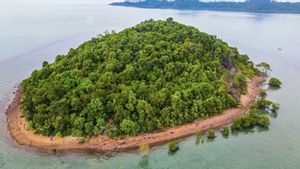JAKARTA - In the middle of a vast ocean, there is a small island that has extraordinary uniqueness. Grimsey Island in Iceland has an area of 6.5 kilometers. The island is included in the list of one of the most remote settlements in Europe.
Reported by VOI from the Times of India website on Tuesday, December 17, 2024, Grimsey Island is not like other islands that are busy with human life.
The island is only inhabited by about 20 people, but has more than 1 million birds that are the main residents of the island.
Despite the stunning view, life here is very difficult and full of uncertainty, as small communities struggle to survive.
According to reports from various online media, thousands of birds come to the island every summer to lay eggs on the cliffs and their rocky beaches.
wahin, the Arctic, raziorbill, and guillemot birds are the most common birds found here. This location makes it a true paradise for bird observers.
SEE ALSO:
Biodiversity on this island is not just about birds. Iceland's sheep and horses are free to roam, grazing on the island's uneven land, and adding to the beauty of nature. This untouched natural beauty feels like something is coming out of a dream.
This island used to be one of the most remote places on Earth for centuries. It is believed that ships come only twice a year and residents living there must depend on their own skills and creativity to survive.
But now, with a better connection, the island is becoming more accessible. You can fly briefly from Akureyri or by ferry from Dalvungk to get to this island.
Although access is easier, life on the island is still very tough. A long and hard winter with freezing temperatures and strong winds, forcing people living here throughout the year to face isolation and supply constraints.
According to media reports, fisheries has always been the main livelihood of the island, but the government's restrictions on fisheries are increasingly making things difficult. These regulations require residents to build fish processing facilities, which are certainly difficult for the community to do at this small.
As a result, many fishermen were forced to stop their jobs. Although tourism brings little revenue during the summer months, it is not enough to support the island's economy throughout the year.
This island used to have a rapidly growing community. But now only 20 inhabitants remain. Most of the houses are empty during winter, as many people move to the mainland to look for better opportunities.
In the summer, the island becomes bustling as tourists come to see the birds and enjoy the beauty of the Arctic. After the birds leave, the island returns to being lonely and empty, with few people living there facing the challenges of everyday life.
Gr usulmsey is not only home to birds, but also a very important part of Iceland's history. Humans have lived there since the early days of settlement, and this shows the strength and determination of those who choose to live in this very remote and challenging place.
According to media sources, government officials, including Iceland's Minister of Food, Agriculture, and Fisheries, Bjarkey Olsen Gunnarsdhattir, are aware of the challenges Grtamamsey faces. There has been talk of a solution, but so far no concrete steps have been taken.
The English, Chinese, Japanese, Arabic, and French versions are automatically generated by the AI. So there may still be inaccuracies in translating, please always see Indonesian as our main language. (system supported by DigitalSiber.id)











